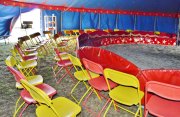 There's a huge gulf between an evening at the ballet and a trip to the circus.
There's a huge gulf between an evening at the ballet and a trip to the circus.For a start, ballet is for adults; devotees speak of the flow of emotion, movement and music combining to tell timeless stories. It may cost a packet, but it's a sophisticated evening in a classy environment.
The circus is a complete contrast; aimed primarily at children, its sequence of short unrelated acts provides them with all the thrills, spills and (hopefully) laughter they could want. Tickets are cheap, but beware the cornucopia of popcorn and plastic you'll be expected to buy.
The two experiences have virtually nothing in common. You could say they have no shared ground at all. Unless of course, you've ever been to see Cirque du Soleil. Cirque fits slap bang in the middle of that gulf. In fact, they own it.
At a recent breakfast seminar I spoke about how to find, and own, a niche in the market. One concept I shared was the "value model", and one of the examples I used was retail. It goes like this: the three biggest costs in running a supermarket are the property, the people and the stock. And for most UK shoppers, the choice falls into three tiers.
At the high end, you have Waitrose and M&S. They have medium-sized, well invested stores; a medium sized range of high priced stock; and a high level of well trained staff. Of course there are differences between M&S and Waitrose, but they're tiny compared with the gap to the group below.
That's the group with the big four supermarkets. All have mainly big stores; a huge stock of low to mid-price products; and medium-sized complement of low-paid staff. Ironically, the more those in this group focus on competing with each other, the more indistinguishable they become. They're all desperate to be different in exactly the same way, and as a result, they all fail the differentiation test.
For years, Sainsburys tried to create a middle ground, above the mass group but below the top-enders, but they never managed to make it work. It seemed there was no gap in the market to be had. That is of course until Aldi found it.
Aldi have comparatively small, inexpensively fitted shops; they have a very tight range and an incredibly efficient supply chain meaning their cost of stock is a fraction of their turnover; and despite paying higher wages, their overall staffing cost is considerably cheaper.
Aldi have essentially stripped out huge chunks of the sector's three biggest cost areas, and invested the savings in product, price and efficiency, to create a highly distinctive, and extremely popular value proposition. In exactly the same way, Cirque du Soleil stripped out the most expensive elements of circus (the animals) and ballet (the stars and the stories) to create their own unique value proposition: classy environment with music, movement and story, thrills, spills, and humour for all ages, for a high price, and without the tat.
So here's the challenge: take a look at your competitive set. Are you all different in the same way? Are there different clusters with a gulf in between? Could you challenge your industry's "value model" by stripping out its biggest costs, if you came at things from a completely new angle?
Bottom Line: there are always opportunties to create a new gap, a new niche, in even the most established markets. The question is: will it be you, or someone else, who finds it first?